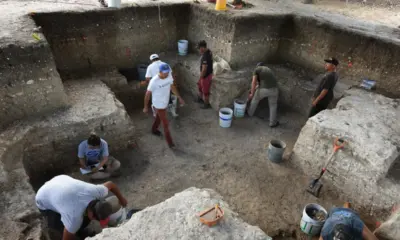Science
Archaeologists Discover Ancient 3,000-Year-Old Cosmic Map in Mexico

A team of archaeologists has unveiled a remarkable discovery at the ancient site of Aguada Fénix in Mexico, revealing a 3,000-year-old map of the cosmos. This groundbreaking finding sheds light on the Maya civilization’s understanding of the universe and their cosmological beliefs.
The cross-shaped pit, which was uncovered during recent excavations, is part of a monumental complex that has intrigued researchers since its discovery several years ago. This site, located in the state of Tabasco, is believed to date back to around 1,000 BCE, making it one of the oldest known ceremonial sites in the region.
Insights into Maya Cosmology
According to a study published by the University of Pennsylvania, the layout of the pit suggests an intricate understanding of celestial bodies. The cross shape may represent significant astronomical alignments, reflecting how the Maya viewed the cosmos. The researchers highlight that this discovery could provide valuable insights into their rituals and societal structure.
The excavation team, led by archaeologist Dr. Takeshi Inomata, noted that the site’s design aligns with key astronomical events. “The positioning of the pit indicates a sophisticated level of planning and a deep connection with the cosmos,” Dr. Inomata stated. He emphasized that this finding could change how scholars interpret Maya civilization and their relationship with the universe.
Historical Context and Significance
Aguada Fénix is not just significant for its astronomical implications; it also offers a glimpse into the architectural prowess of the ancient Maya. The complex features large earthworks, and the recent discoveries have prompted further investigations into its purpose and the culture that built it.
The site has been recognized as a UNESCO World Heritage site, underscoring its importance in understanding the early Maya civilization. As archaeologists continue their work, they hope to uncover more about the rituals and beliefs that shaped this influential culture.
This discovery highlights the ongoing efforts to piece together ancient histories and the significance of archaeological research in revealing the complexities of past societies. The findings at Aguada Fénix contribute to a growing body of evidence that showcases the advanced knowledge and capabilities of the Maya, particularly in relation to astronomy and architecture.
As research continues, experts anticipate that further excavations will yield more insights into the Maya’s intricate relationship with their environment and the cosmos. This 3,000-year-old cosmic map not only enriches our understanding of Maya astronomy but also serves as a reminder of the sophistication of ancient civilizations that laid the foundations for future societies.
-

 Technology5 months ago
Technology5 months agoDiscover the Top 10 Calorie Counting Apps of 2025
-

 Health3 months ago
Health3 months agoBella Hadid Shares Health Update After Treatment for Lyme Disease
-

 Health3 months ago
Health3 months agoErin Bates Shares Recovery Update Following Sepsis Complications
-

 Technology4 months ago
Technology4 months agoDiscover How to Reverse Image Search Using ChatGPT Effortlessly
-

 Technology1 month ago
Technology1 month agoDiscover 2025’s Top GPUs for Exceptional 4K Gaming Performance
-

 Technology3 months ago
Technology3 months agoElectric Moto Influencer Surronster Arrested in Tijuana
-

 Technology5 months ago
Technology5 months agoMeta Initiates $60B AI Data Center Expansion, Starting in Ohio
-

 Technology5 months ago
Technology5 months agoRecovering a Suspended TikTok Account: A Step-by-Step Guide
-

 Health4 months ago
Health4 months agoTested: Rab Firewall Mountain Jacket Survives Harsh Conditions
-

 Lifestyle5 months ago
Lifestyle5 months agoBelton Family Reunites After Daughter Survives Hill Country Floods
-

 Technology4 months ago
Technology4 months agoHarmonic Launches AI Chatbot App to Transform Mathematical Reasoning
-

 Health3 months ago
Health3 months agoAnalysts Project Stronger Growth for Apple’s iPhone 17 Lineup



















